#matrika
Explore tagged Tumblr posts
Text
Finally finished the drawing for real
@zeherili-ankhein @h0bg0blin-meat @hydestudixs

Devarani Aindri
Also, here's what I think would fit best as Her theme:
#my art#indrani#aindri#shachi#matrika#devi#hindu goddess#hindu art#mythological art#hindublr#desiblr#Spotify#bluboi art
48 notes
·
View notes
Text

Grahamatrika
#Grahamatrika#Grahamātṛkā#vajra#mandala#buddhism#tibetan buddhism#buddhist deity#dharani#mantra#matri#matrika#matar#Vidyarajni#Mahavidya#female deity
19 notes
·
View notes
Text

Chamunda (चामुण्डा) is a fearsome form (उग्र - ugra) of the mother goddess Mahadevi worshipped by ritual animal sacrifices along with offerings of wine and in the ancient times, human sacrifices. She is one of the seven Matrikas (मातृका - mothers) of hinduism and a tantric goddess. She is identified with goddesses Parvati, Chandi, Kali and Durga.
Chamunda is described as wearing a garland of severed heads or skulls (Mundamala). She is described as having four, eight, ten or twelve arms, holding a Damaru (drum), trishula (trident), sword, snake, skull-mace (khatvanga), thunderbolt, a severed head and panapatra (drinking vessel) or skull-cup (kapala), filled with blood. She stands or sits upon the corpse of a man (shava or preta), a defeated demon or corpse. She is adorned with bones, skulls, and serpents. She also wears a Yajnopavita (sacred thread) of skulls. She wears a jata mukuta, that is, a headdress formed of piled, matted hair tied together with snakes or skull ornaments. Sometimes, a crescent moon is seen on her head. Her eye sockets are described as burning the world with flames. She is accompanied by spirits. She is also shown to be surrounded by skeletons, ghosts and beasts like jackals, who are shown eating the flesh of the corpse the goddess sits or stands on.
#chamunda#darkgoddess#tantricgoddess#preta#parvati#chandi#mahadevi#sacrifice#sinisterfeminine#matrika#ritualsacrifice#blood#chandika#corpse#unvolk#hinduism#kali#durga#ugra#mundamala#skulls#demons#jackals#kapala#snake#khatvanga#ghosts#dhole
7 notes
·
View notes
Text
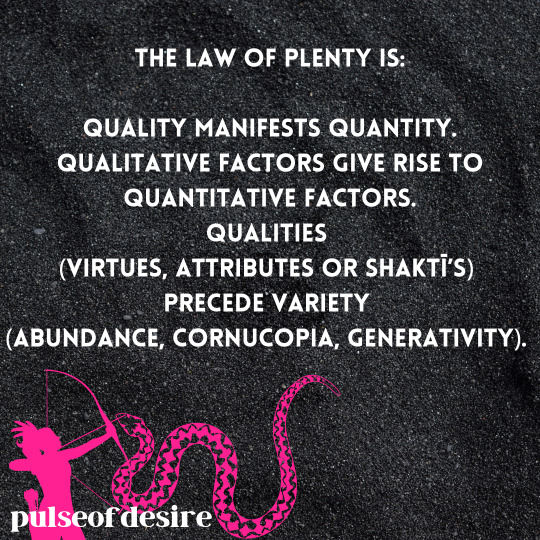
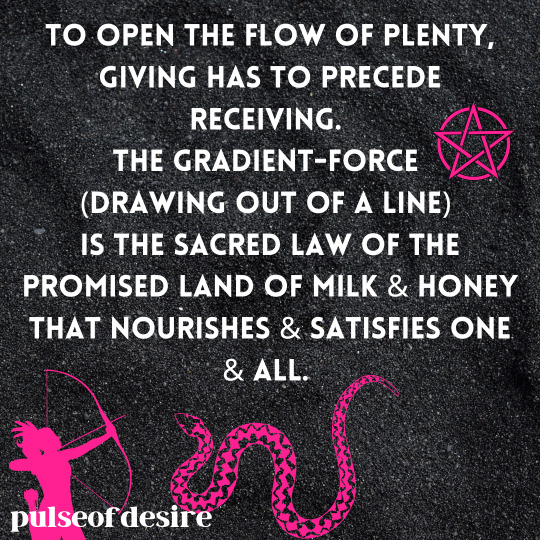
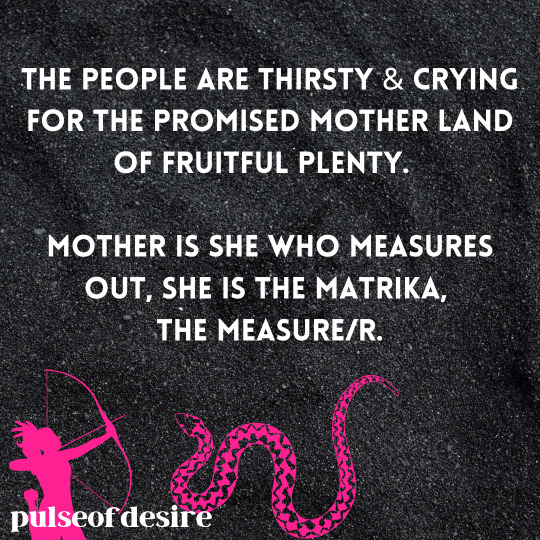
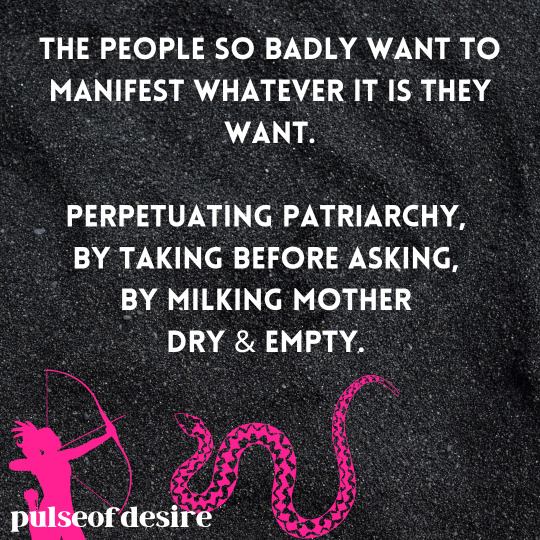

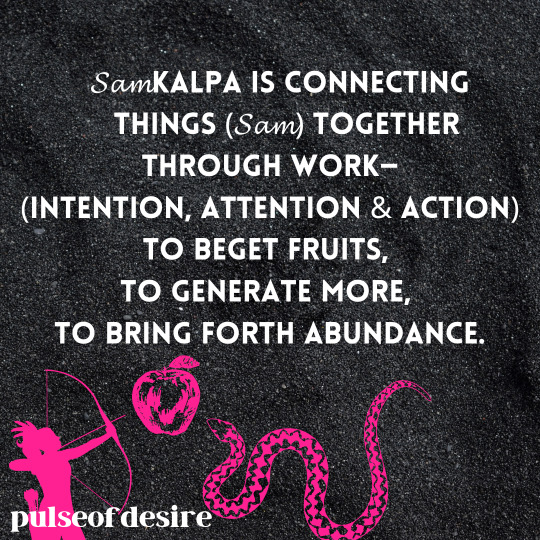
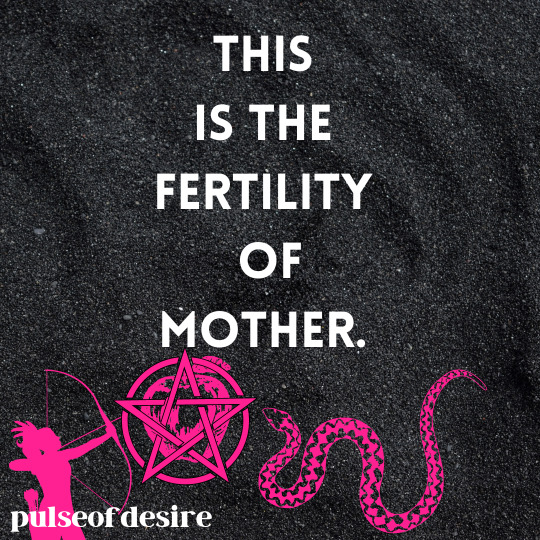
𝐐𝐔𝐀𝐋𝐈𝐓𝐈𝐄𝐒
Manifestation of heart’s desire
The rule/law is this—
Quality manifests quantity.
Qualitative factors give rise to quantitative factors.
Qualities (virtues, attributes or Shaktī’s) precede Variety (abundance, cornucopia, generativity).
To open the flow of plenty, giving has to precede receiving. The gradient-force (drawing out of a line) is the sacred law of the promised land of milk & honey that nourishes & satisfies one & all.
The people are thirsty & crying for the promised Mother land of fruitful plenty.
Mother is she who measures out, she is the Matrika, the Measure/r.
The people so badly want to manifest whatever it is they want.
Perpetuating patriarchy, by taking before asking, by milking Mother dry & empty.
Fruitfulness results from bringing things together correctly, seed in soil with water & light yields trees with fruits of plenty.
𝓢𝓪𝓶kalpa is connecting things (𝓢𝓪𝓶) through work (intention, attention & action) to beget fruits, to generate more, to bring forth abundance.
This is the fertility of Mother.
#fruitfulness#abundance#manifest#magic#witch#animism#mother#energy#matrons#matriarchal#matrika#law of attraction#natural laws#polarity#virtue#dharma#natural law#feminine magic#shakti#creativity#fertility#cornucopia#presence
3 notes
·
View notes
Text



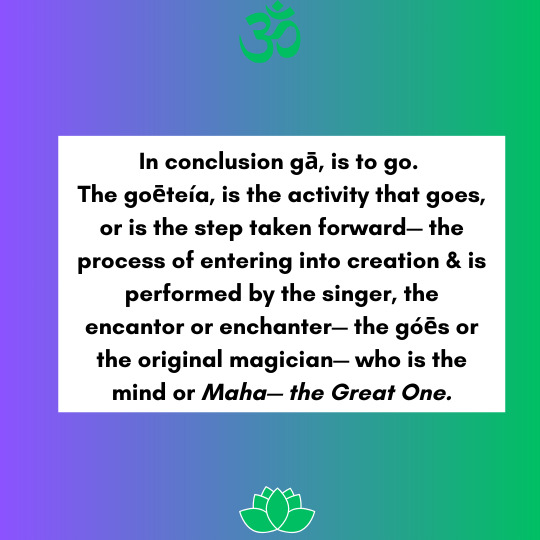






Part of a preamble on the Bhagavad Gita part 2/2
There is the saying, cry me a river— & so the flow of creation originates in the source, the eternal eye of God- said to be produced from incantation of sacred mantra or measures— this is a function of Goddess, standing on the edge between unmanifest & manifest, the dead & the living—
The action of incanting brings about & sustains the life-current & incantation also means to pour forth from on high.
So our journey through the Bhagavad Gita, may begin.
#incantation #mantra #songofgod #goddess #bagavadgita
#sacredsound #maya #sacredriver #waterwisdom #motiveforce #shakti #shiva #ganges #magdalene
#Magdalene#Mary#mer#mari#consciousness#spiritual#presence#heart#awareness#nonduality#selfrealization#spirituality#advaita#divinemother#water priestess#birth priestess#rebirth priestess#rebirth#rites#death and rebirth#wailing#siren#flow#creation#water witch#mantra#Matrika#mantic#mantism#moon
1 note
·
View note
Text
स्कंदमाता: शक्ती आणि मातृत्वाची देवी
स्कंदमाता, देवी पार्वतीच्या पाचव्या रूपात, भक्तांच्या हृदयांमध्ये विशेष स्थान ठेवते. ती आपल्या पुत्र स्कंद (कार्तिकेय)ची माता आहे, ज्याच्या साहाय्याने ती युध्दात विजय प्राप्त करतात. नवरात्रीच्या पाचव्या दिवशी तिची पूजा केली जाते, आणि तिचा महिमा अनंत आहे. स्कंदमातेचां महिमा 1. पुत्रप्रेम आणि मातृत्व: स्कंदमाता सर्व मातांचे प्रतीक आहे. तिचे प्रेम आणि दयाळूपणा निसर्गाशी संबंधित आहेत. ती आपल्या…

View On WordPress
#CulturalHeritage#DeviMahima#DeviShakti#DivineBlessings#DivineFeminine#Divinity#faith#GoddessEnergy#GoddessWorship#Hinduism#MaaDurga#MaaParvati#Matrika#Navratri#Nurturing#ReligiousFestivals#SacredText#Sanskrit#Spirituality#WomenEmpowerment
0 notes
Text
Vždycky, když se mě někdo zeptá, jak přesně se jmenuju, a já se to otráveně chystám slabikovat, si vzpomenu, že celkem dost lidí v téhle zemi se jmenuje V/Wá/agner(ová) (a jeden pán v Jindřichově Hradci Wägner).
1 note
·
View note
Link
The Ashta Matrika, often referred to as the "Eight Mothers," are a revered group of goddesses deeply rooted in Hinduism.
0 notes
Photo

#matrika #giltbronze #nepal #14thcentury #motog825gshot (at Prince Of Wales Museum) https://www.instagram.com/p/Cpreqv8PJmp/?igshid=NGJjMDIxMWI=
0 notes
Note
Oh also @hydestudixs and I were discussing about how Vishnu is the only male deity that is more commonly considered a form of Shakti (thus making Harihar canonically married lmao) than any other male deities and that makes sense cuz he dedass became a mother at a lot of instances right
Which makes me think.... Would he be a part of the Matrika Squad? ���
Also it's hilarious but also cool how he's the og ✨one of the gworls✨ by this logic
LMAO
What if he's yk that uncle that hangs out with moms and aunties of the colony?? (Im so adding that to my modern day househusband Vishnu au)
Also yeahhhh he's one of the girlss 💅✨ and the one who is ACTUALLY understands us the best 🗿🗿🗿✨✨
Be honest he got the best gossips during the Matrika spa session or something lol..
Also there's this anime/manga ‘The Way Of The Househusband’ and it gives so much of Vishnu vibes to me lol
13 notes
·
View notes
Text
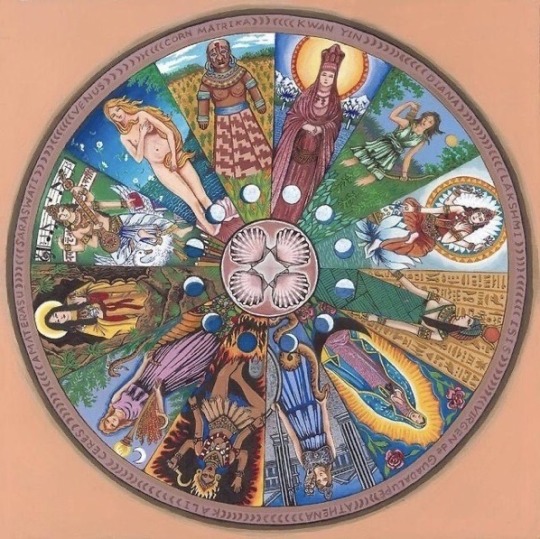
#venus#kali#isis#diana#ceres#athena#kwan yin#lakshmi#amaterasu#saraswati#corn matrika#virgin de guadalupe
47 notes
·
View notes
Text

The outstretched tongue of Maa Kali distinguishes her from all other gods and goddesses of the Hindu pantheon. There are many goddesses who, like Kali, are naked and associated with blood and death, including Chandi, Chamunda, Bhairavi and Bhagavati, but none stick out their tongue like Maa Kali. Sometimes Kali does not have the characteristic outstretched tongue. She has fangs protruding from the corners of the mouth. This is especially popular in south Indian imagery. A Kali without the tongue is called Bhadra-Kali or the decent-Kali who does not reject feminine grace totally. She resides in household shrines and serves as the guardian of the family. In Devi Mahatmya, Kali unfurls her tongue in her role as the ultimate deliverer called upon to salvage a situation that seems hopelessly out of control. She is summoned by Maa Durga herself to destroy the demon Rakta-bija, whose name means ‘blood-seed’. The demon Rakta-bija had the magical ability to produce a double of himself instantly every time a drop of his blood fell to the ground. Having wounded Rakta-bija with a variety of weapons, Durga and her assistants, a fierce band of warriors known as the Matrikas, find they have worsened the situation: as Rakta-bija bleeds more profusely from his wounds, the battlefield gets filled with Rakta-bija duplicates. Desperate, Durga summons Kali, who spreads her tongue across the battlefield, and swallows in one gulp, the swarm of blood-born demons and sucks the blood from the original Rakta-bija until he falls lifeless. Kali’s tongue here is a weapon, to be feared, a reminder that nature ultimately consumes all life. After killing the demon Daruka, Kali drank his blood. The blood drove her mad with bloodlust. She went around the world killing at random. The gods begged Shiva to stop her. So he took the form of a handsome man and lay in Kali’s path. As soon as Kali stepped on him, she bit her tongue out of embarrassment. She was ashamed to learn that her bloodlust had prevented her from seeing and recognising her own husband, Shiva! 💀👅💀 Jai Maa Kali ~ Jai Shiva Shankar Tongue of Maa Kali Talon Abraxas
80 notes
·
View notes
Text
Origins of the Pibo: Let’s take a trip along the Silk Road.
1. Introduction to the garment:
Pibo 披帛 refers to a very thin and long shawl worn by women in ancient East Asia approximately between the 5th to 13th centuries CE. Pibo is a modern name and its historical counterpart was pei 帔. But I’ll use pibo as to not confuse it with Ming dynasty’s xiapei 霞帔 and a much shorter shawl worn in ancient times also called pei.
Below is a ceramic representation of the popular pibo.
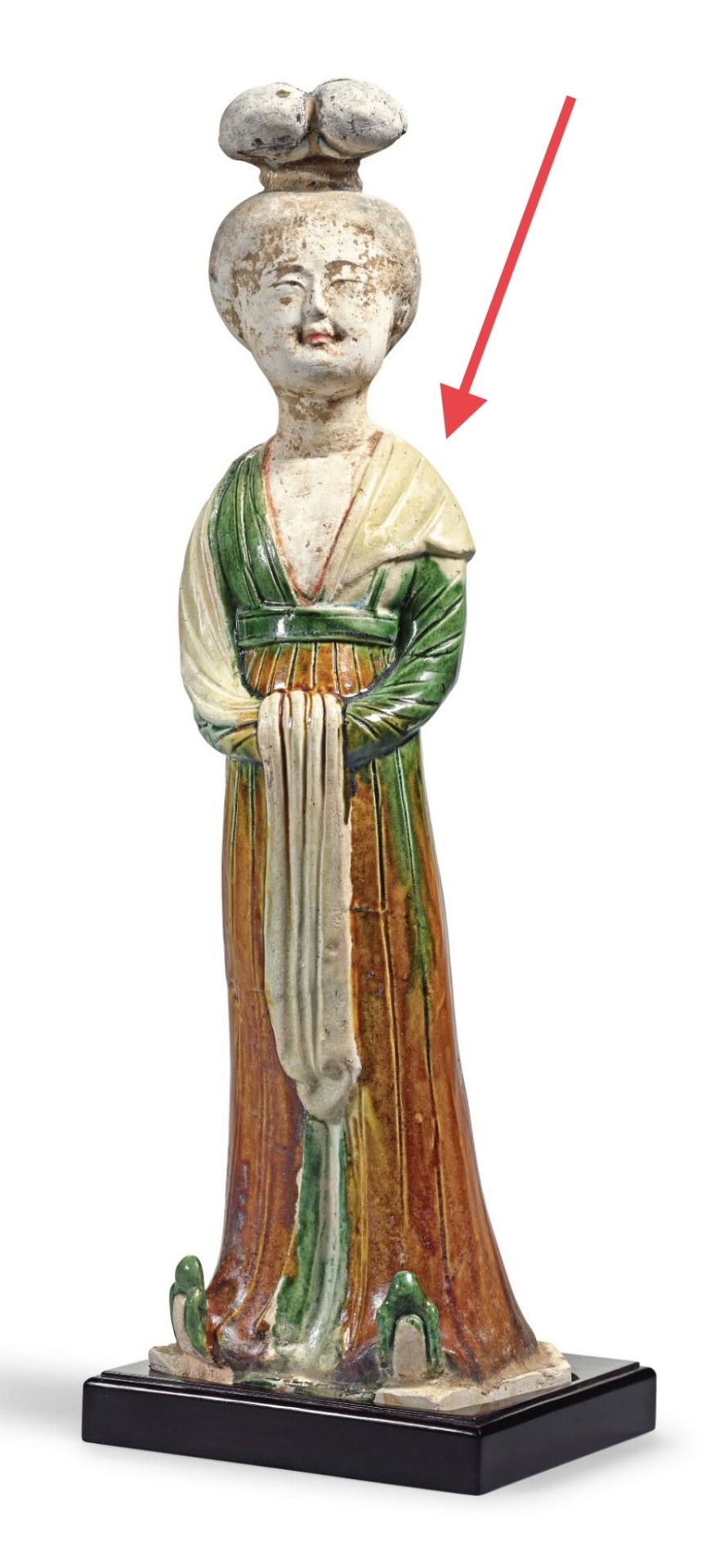
A sancai-glazed figure of a court lady, Tang Dynasty (618–690, 705–907 CE) from the Sze Yuan Tang Collection. Artist unknown. Sotheby’s [image source].
Although some internet sources claim that pibo in China can be traced as far back as the Qin (221-206 BCE) or Han (202 BCE–9 CE; 25–220 CE) dynasties, we don’t start seeing it be depicted as we know it today until the Northern and Southern dynasties period (420-589 CE). This has led to scholars placing pibo’s introduction to East Asia until after Buddhism was introduced in China. Despite the earliest art representations of the long scarf-like shawl coming from the Northern and Southern Dynasties period, the pibo reached its popularity apex in the Tang Dynasty (618–690 CE: 705–907 CE).
Academic consensus: Introduction via the Silk Road.
The definitive academic consensus is that pibo evolved from the dajin 搭巾 (a long and thin scarf) worn by Buddhist icons introduced to China via the Silk Road from West Asia.
披帛是通过丝绸之路传入中国的西亚文化, 与中国服饰发展的内因相结合而流行开来的一种"时世妆" 的形式. 沿丝绸之路所发现的披帛, 反映了丝绸贸易的活跃.
[Trans] Pibo (a long piece of cloth covering the back of the shoulders) was a popular female fashion period accessory introduced to China by West Asian cultures by way of the Silk Road and the development of Chinese costumes. The brocade scarves found along the Silk Road reflect the prosperity of the silk trade that flourished in China's past (Lu & Xu, 2015).
I want to add to the above theory my own speculation that, what the Chinese considered to be dajin, was most likely an ancient Indian garment called uttariya उत्तरीय.
2. Personal conjecture: Uttariya as a tentative origin to pibo.
In India, since Vedic times (1500-500 BCE), we see mentions in records describing women and men wearing a thin scarf-like garment called “uttariya”. It is a precursor of the now famous sari. Although the most famous depiction of uttariya is when it is wrapped around the left arm in a loop, we do have other representations where it is draped over the shoulders and cubital area (reverse of the elbow).
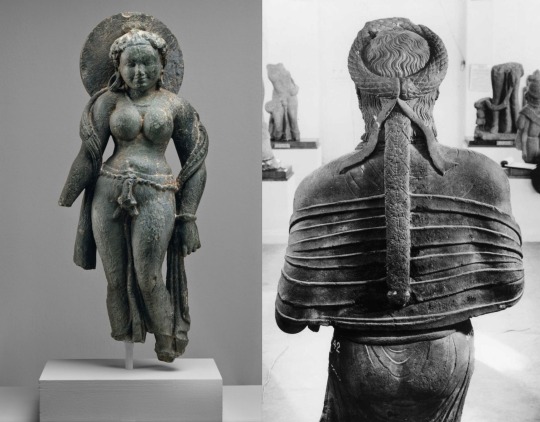
Left: Hindu sculpture “Mother Goddess (Matrika)”, mid 6th century CE, gray schist. Artist unknown. Looted from Rajasthan (Tanesara), India. Photo credit to Metropolitan Museum of Art, New York, United States [image source].
Right: Rear view of female statue possibly representing Kambojika, the Chief Queen of Mahakshatrapa Rajula, ca. 1st century CE. Artist unknown. Found in the Saptarishi Mound, Mathura, India. Government Museum, Mathura [image source].
Buddhism takes many elements from Hindu mythology, including apsaras अप्सरा (water nymphs) and gandharvas गन्धर्व (celestial musicians). The former was translated as feitian 飞天 in China. Hindu deities were depicted wearing clothes similar to what Indian people wore, among which we find uttariya, often portrayed in carvings and sculptures of flying and dancing apsaras or gods to show dynamic movement. Nevertheless, uttariya long predated Buddhism and Hinduism.
Below are carved representation of Indian apsaras and gandharvas. Notice how the uttariya are used.
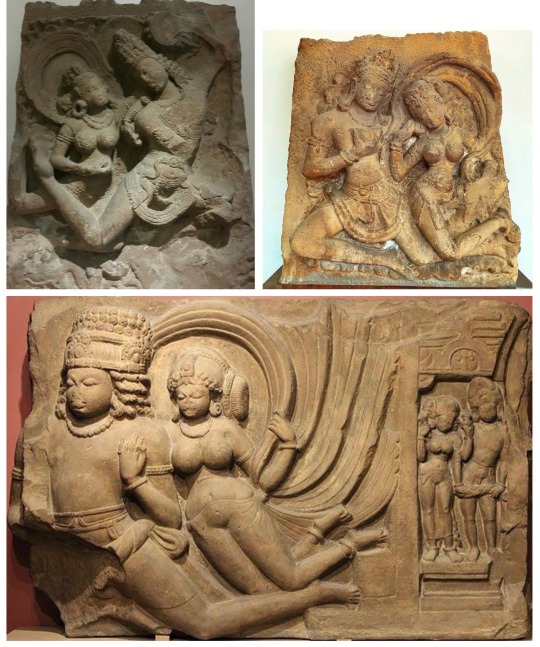
Upper left: Carved relief of flying celestials (Apsara and Gandharva) in the Chalukyan style, 7th century CE, Chalukyan Dynasty (543-753 CE). Artist Unknown. Aihole, Karnataka, India. National Museum, New Delhi, India [image source]. The Chalukyan art style was very influential in early Chinese Buddhist art.
Upper right: Carved relief of flying celestials (gandharvas) from the 10th to the 12th centuries CE. Artist unknown. Karnataka, India. National Museum, New Delhi, India [image source].
Bottom: A Viyadhara (wisdom-holder; demi-god) couple, ca. 525 CE. Artist unknown. Photo taken by Nomu420 on May 10, 2014. Sondani, Mandsaur, India [image source].
Below are some of the earliest representations of flying apsaras found in the Mogao Caves, Gansu Province, China. An important pilgrimage site along the Silk Road where East and West met.
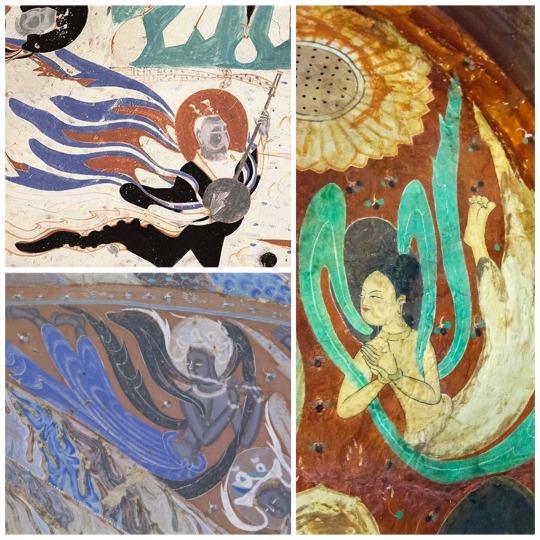
Left to right: Cave No. 461, detail of mural in the roof of the cave depicting either a flying apsara or a celestial musician. Western Wei dynasty (535–556 CE). Artist unknown. Mogao Grottoes, Dunhuang, China [image source].
Cave 285 flying apsara (feitian) in one of the Mogao Caves. Western Wei Dynasty (535–556 CE), Artist unknown. Photo taken by Keren Su for Getty Images. Mogao Grottoes, Dunhuang, China [image source].
Cave 249. Mural painting of feitian playing a flute, Western Wei Dynasty (535-556 CE). Image courtesy by Wang Kefen from The Complete Collection of Dunhuang Grottoes, Vol. 17, Paintings of Dance, The Commercial Press, Hong Kong, 2001, p. 15. Mogao Grottoes, Dunhuang, China [image source].
I theorize that it is likely that the pibo was introduced to China via Buddhism and Buddhist iconography that depicted apsaras (feitian) and other deites wearing uttariya and translated it to dajin.
3. Trickle down fashion: Buddhism’s journey to the East.
However, since Buddhism and its Indian-based fashion spread to West Asia first, to Sassanian Persians and Sogdians, it is likely that, by the time it reached the Han Chinese in the first century CE, it came with Persian and Sogdian influence. Persians’ fashion during the Sassanian Empire (224–651 CE) was influenced by Greeks (hellenization) who also had a a thin long scarf-like garment called an epliblema ἐπίβλημα, often depicted in amphora (vases) of Greek theater scenes and sculptures of deities.
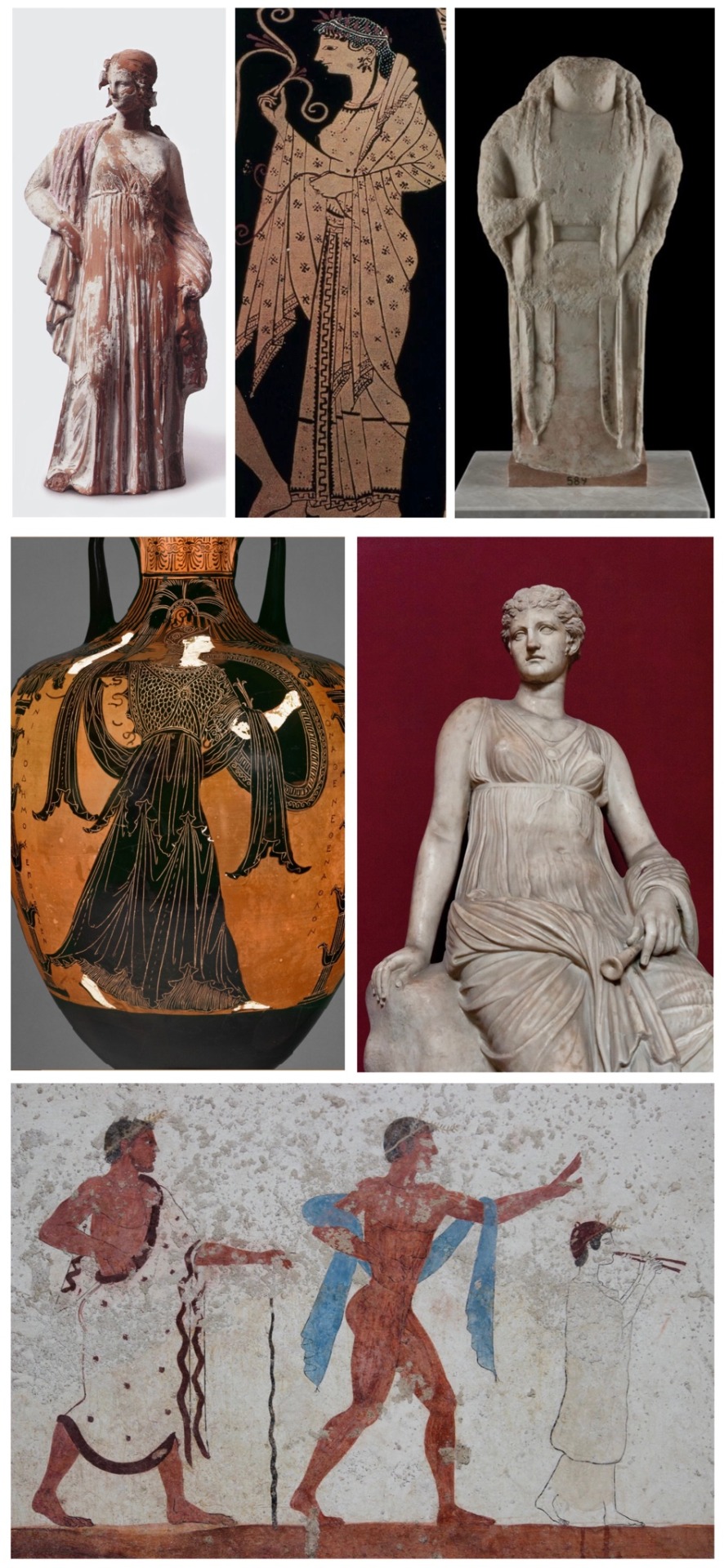
Left to right: Dame Baillehache from Attica, Greece. 3rd century BCE, Hellenistic period (323-30 BCE), terracotta statuette. Photo taken by Hervé Lewandowski. Louvre Museum, Paris, France [image source].
Deatail view of amphora depicting the goddess Artemis by Athenian vase painter, Andokides, ca. 525 BCE, terracotta. Found in Vulci, Italy. Altes Museum, Berlin, Germany [image source].
Statue of a Kore (young girl), ca. 570 BCE, Archaic Period (700-480 BCE), marble. Artist unknown. Uncovered from Attica, Greece. Acropolis Museum, Athens, Greece [image source].
Detail view of Panathenaic (Olympic Games) prize amphora with lid, 363–362 BCE, Attributed to the Painter of the Wedding Procession and signed by Nikodemos, terracotta. Uncovered from Athens, Greece. J. Paul Getty Museum, Los Angeles, California, United States [image source].
Roman statue depicting Euterpe, muse of lyric poetry and music, ca. 2nd century CE, marble, Artist unknown. From the Villa of G. Cassius Longinus near Tivoli, Italy. Photo taken by Egisto Sani on March 12, 2012, Vatican Museums, Rome, Italy [image source].
Greek (or Italic) tomb mural painting from the Tomb of the Diver, ca. 470 BCE, fresco. Artist unknown. Photo taken by Floriano Rescigno. Necropolis of Paestum, Italy [image source].
Below are Iranian and Iraqi period representations of this long thin scarf.

Left to right: Closeup of ewer likely depicting a female dancer from the Sasanian Period (224–651 CE) in ancient Persia , Iran, 6th-7th century CE, silver and gilt. Artist unknown. Mary Harrsch. July 10, 2015. Arthur M. Sackler Gallery of Asian Art, Smithsonian, Washington D.C [image source].
Ewer with nude dancer probably representing a maenad, companion of Dionysus from the Sasanian Period (224–651 CE) in ancient Persia, Iran, 6th-7th century CE, silver and gilt. Artist unknown. Mary Harrsch. July 16, 2015. Arthur M. Sackler Gallery of Asian Art, Smithsonian, Washington D.C [image source].
Painting reconstructing the image of unveiled female dancers depicted in a fresco, Early Abbasid period (750-1258 CE), about 836-839 CE from Jawsaq al-Khaqani, Samarra, Iraq. Museum of Turkish and Islamic Art, Istanbul [image source].
The earliest depictions of Buddha in China, were very similar to West Asian depictions. Ever wonder why Buddha wears a long draped robe similar to a Greek himation (Romans called it toga)?
Take a look below at how much the Greeks influenced the Kushans in their art and fashion. The top left image is one of the earliest depictions of Buddha in China. Note the similarities between it and the Gandhara Buddha on the right.
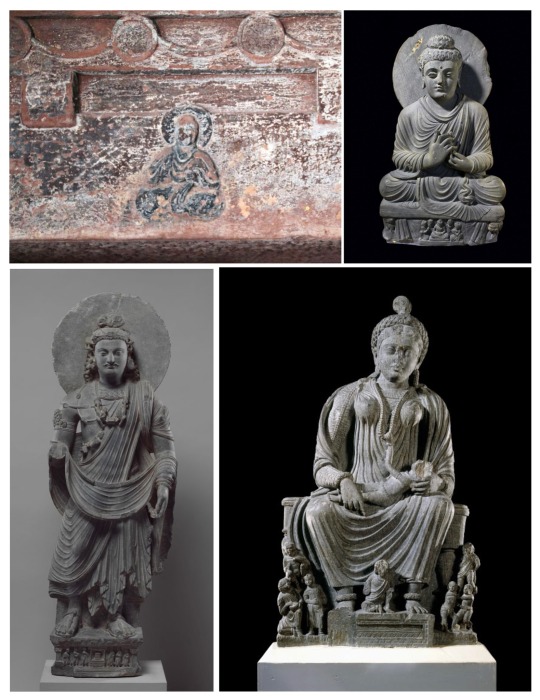
Left: Seated Buddha, Mahao Cliff Tomb, Sichuan Province, Eastern Han Dynasty, late 2nd century C.E. (photo: Gary Todd, CC0).
Right: Seated Buddha from Gandhara, Pakistan c. 2nd–3rd century C.E., Gandhara, schist (© Trustees of the British Museum)
Standing Bodhisattva Maitreya (Buddha of the Future), ca. 3rd century, gray schist. From Gandhara, Pakistan. Image credit to The Metropolitan Museum of Art, New York City, United States [image source].
Statue of seated goddess Hariti with children, ca. 2nd to 3rd centuries CE, schist. Artist unknown. From Gandhara, Pakistan. The British Museum, London, England [image source].
Before Buddhism spread outside of Northern India (birthplace), Indians never portrayed Buddha in human form.
Early Buddhist art is aniconic, meaning the Buddha is not represented in human form. Instead, Buddha is represented using symbols, such as the Bodhi tree (where he attained enlightenment), a wheel (symbolic of Dharma or the Wheel of Law), and a parasol (symbolic of the Buddha’s royal background), just to name a few. […] One of the earliest images [of Buddha in China] is a carving of a seated Buddha wearing a Gandharan-style robe discovered in a tomb dated to the late 2nd century C.E. (Eastern Han) in Sichuan province. Ancient Gandhara (located in present-day Afghanistan, Pakistan, and northwest India) was a major center for the production of Buddhist sculpture under Kushan patronage. The Kushans occupied portions of present-day Afghanistan, Pakistan, and North India from the 1st through the 3rd centuries and were the first to depict the Buddha in human form. Gandharan sculpture combined local Greco-Roman styles with Indian and steppe influences (Chaffin, 2022).
In the Mogao Caves, which contain some of the earliest Buddhist mural paintings in China, we see how initial Chinese Buddhist art depicted Indian fashion as opposed to the later hanfu-inspired garments.
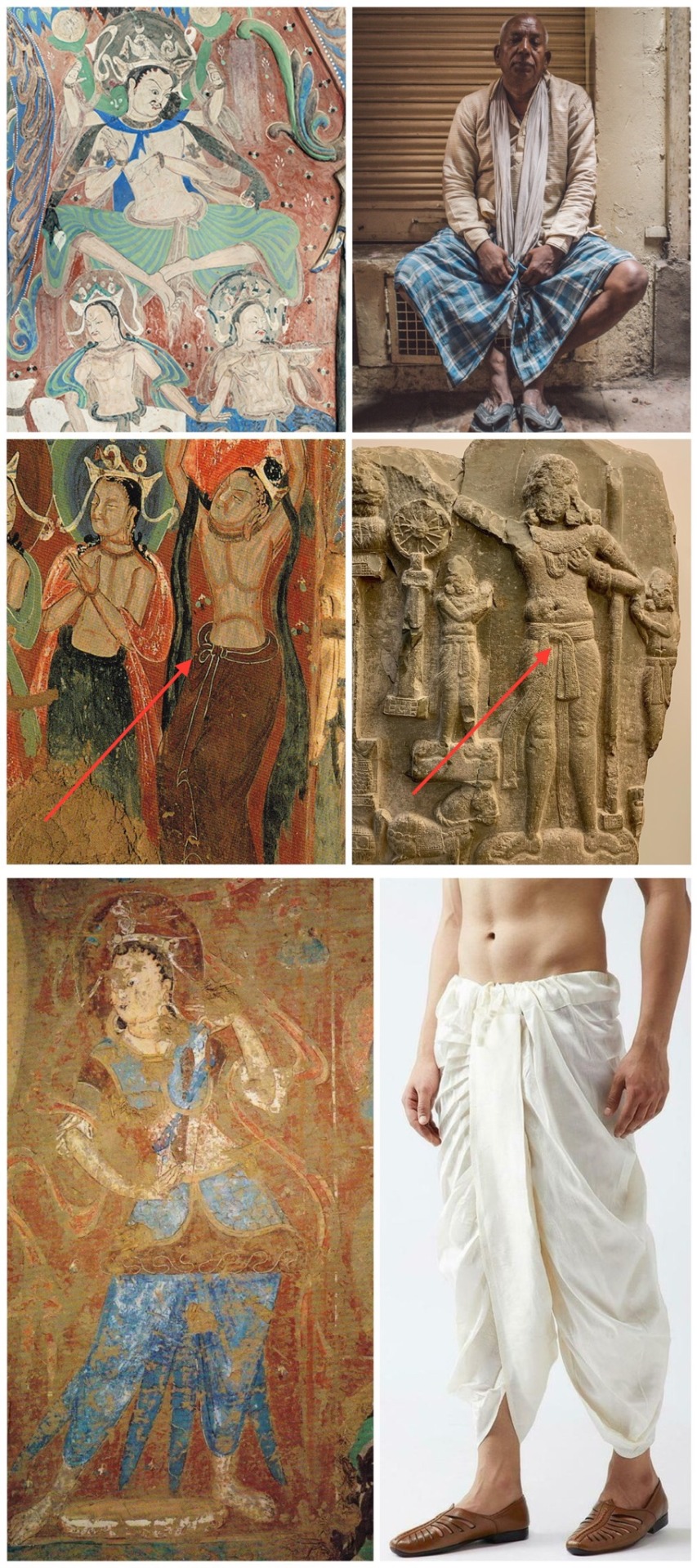
Left to right: Cave 285, detail of wall painting, Western Wei dynasty (535–556 CE). Mogao Grottoes, Dunhuang, China. Courtesy the Dunhuang Academy [image source]. Note the clothes the man is wearing. It looks very similar to a lungi (a long men’s skirt).
Photo of Indian man sitting next to closed store wearing shirt, scarf, lungi and slippers. Paul Prescott. February 20, 2015. Varanasi, India [image source].
Cave 285, mural depiction of worshipping bodhisattvas, 6th century CE, Wei Dynasty (535-556 A.D.), Unknown artist. Mogao Grottoes, Dunhuang, China. Notice the half bow on his hips. That is a common style of tying patka (also known as pataka; cloth sashes) that we see throughout Indian history. Many of early Chinese Buddhist paintings feature it, including the ones at Mogao Caves.
Indian relief of Ashoka wearing dhoti and patka, ca. 1st century BC, Unknown artist. From the Amaravathi village, Guntur district, Andhra Pradesh, India. Currently at the Guimet Museum, Paris [image source].
Cave 263. Mural showing underlying painting, Northern Wei Dynasty (386–535 CE). Artist Unknown. Picture taken November 29, 2011, Mogao Grottoes, Dunhuang, China [image source]. Note the pants that look to be dhoti.
Comparison photo of modern dhoti advertisement from Etsy [image source].
Spread of Buddhism to East Asia.

Map depicting the spread of Buddhism from Northern India to the rest of Asia. Gunawan Kartapranata. January 31, 2014 [image source]. Note how Mahayana Buddhism arrived to China after passing through Kushan, Bactrean, and nomadic steppe lands, absorbing elements of each culture along the way.
Wealthy Buddhist female patrons emulated the fantasy fashion worn by apsaras, specifically, the uttariya/dajin and adopted it as an everyday component of their fashion.
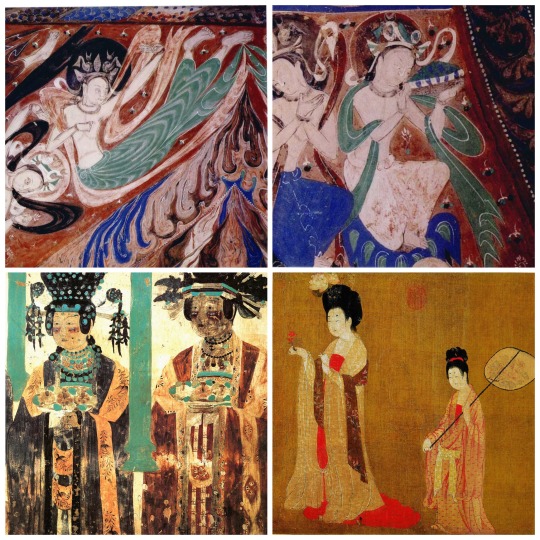
Cave 285. feitian mural painting on the west wall, Western Wei Dynasty (535–556 CE). Artist unknown. Mogao Grottoes, Dunhuang, China [image source].
Cave 285. Detail view of offering bodhisattvas (bodhisattvas making offers to Buddha) next to the phoenix chariot on the Western wall of the cave. Western Wei Dynasty (535–556 CE). Artist unknown. Mogao Grottoes, Dunhuang, China [image source].
Cave 61 Khotanese (from the kingdom of Khotan 于阗 [56–1006 CE]) donor ladies, ca. 10th century CE, Five Dynasties period (907 to 979 CE). Artist unknown. Picture scanned from Zhang Weiwen’s Les oeuvres remarquables de l'art de Dunhuang, 2007, p. 128. Uploaded to Wikimedia Commons on October 11, 2012 by Ismoon. Mogao Grottoes, Dunhuang, China [image source].
Detail view of Ladies Adorning Their Hair with Flowers 簪花仕女图, late 8th to early 9th century CE, handscroll, ink and color on silk, Zhou Fang 周昉 (730-800 AD). Liaoning Provincial Museum, Shenyang, China [image source].
Therefore, the theory I propose of how the pibo entered East Asia is:
India —> Greek influenced West Asia (Sassanian Persians, Sogdians, Kushans, etc…) —> Han China —> Rest of East Asia (Three Kingdoms Korea, Asuka Japan, etc…)
Thus, the most likely theory, in my person opinion, is Buddhist iconography depicting uttariya encountered Greek-influenced West Asian Persian, Sogdian, and Kushan shawls, which combined arrived to China but wouldn’t become commonplace there until the explosion in popularity of Buddhism from the periods of Northern and Southern Dynasties to Song.
References:
盧秀文; 徐會貞. 《披帛與絲路文化交流》 [The brocade scarf and the cultural exchanges along the Silk Road]. 敦煌研究 (中國: 敦煌研究編輯部). 2015-06: 22 – 29. ISSN 1000-4106.
#hanfu#chinese culture#chinese history#buddhism#persian#sogdian#kushan#gandhara#indian fashion#uttariya#pibo#history#asian culture#asian art#asian history#asian fashion#east asia#south asia#india#pakistan#iraq#afghanistan#sassanian#silk road#fashion history#tang dynasty#eastern han dynasty#cultural exchange#greek fashion#mogao caves
300 notes
·
View notes
Text
Andhaka - a malevolent asura famed for having a thousand arms, a thousand heads, and twice as many eyes. Some say it's two thousand arms!

His name means "He who darkens" in some versions of the story, he is the son of Shiva and Parvati
In the Shiva Purana, Shiva is meditating and Parvarti covers his eyes in a playful moment of goofing around.
When she covers his third eye, she recoils from its power and it brings sweat to her palm that falls to the groundfrom that meeting of his third eye and her palm/sweat - the drop of sweat that falls to the ground becomes a dark boy who is born blind and ugly to Parvati.
Shiva chastised her on this in that since the child came into creation from their touches meeting, the child is theirs and should be cared for.
Later Hiraṇyākṣa the demon performed a penance in hopes of gaining a boon from Lord Shiva, in this case, to have a son, in which he is gifted the blind boy who is named, Andhaka. After Hiraṇyākṣa is killed, Andhaka is considered the demon king however, since he was born of devas, he is not considered by others an asura, and so he pleads with Brahma (the creator) after being disowned by his tribe - he is granted the boon to become immortal, but Andhaka is warned Shiva can still destroy him he leaves to subdue all his opponents among the asuras and take charge. Later he wages a war against the gods after he contemplates attacking Mount Mandar where Shiva meditates.
During this war, Bali, Andhaka's trusty general, defeats and swallows most of the gods. But Shiva fires a bolt at bali forcing him to regurgitate the gods, and in vengeance swallow Sukra, the guru of the Asuras. Then Shiva and Indra set upon Andhaka, making him bleed only, every drop of his blood spawned more copies of him, so Vishnu created the Matrikas to absorb the blood every time it spilled so no copies could be born.
This is one of the accounts and just a primer of a cool character, I want to do more of these more often, so I figured I'd just start with cool South Asian character--good, evil, neutral, whoever, whatever, cuz there are so many fucking awesome stories.
#folklore#myths#hindu mythology#myth#myths and legends#shiva and parvati#Shiva#Parvati#hindu gods#Andhaka#gods and demons#Shiva Purana#devas#asura#Brahama#Mount Mandar#Southeast Asia#Southeast Asian#Indian mythology#Asian mythology#Asian legends#legends#good evil neutral#stories and adventures#stories and legends#primer#magic
4 notes
·
View notes
Text










Empress/Enchantress & Siddhi- the Natural Magic of Consciousness part 2/2
Continued from previous post
I am the master of time— I create my own story, I have understood the relation between cause & effect, I have understood that the planting of seeds in the fertile womb of Mother, in the deep unconscious & underworld of timeless dream, is how a tree with fruit grows into time, the waking state, becoming my story-line.
I have understood the premise of magic & alchemy. As empress I have been initiated in the underworld fires of Kali/Persephone.
We emanate & shine with the feminine powers & qualities of our awakened Consciousness such as beauty, deep feeling, empathy, intuition, knowledge, wisdom etc.—
We have been gifted by the Goddess & received our natural, feminine, magical powers.
We don't require the opinions of others, we have died to public opinion (the upper-world), nor do we take outer appearances at face value to guide ourselves, we have come into a deeper place of ourselves (walked through the fire of transformation in the underworld of timelessness, the in-between) - to rise & guide ourselves by our true knowing, of good & right.
We govern ourselves under Justice- the balance between give & receive & so forth.
We are the masters of Measure.
Measure has become our superpower.
We have become our own guiding light, our own STAR.
We stand in our deep inner Will- our true agency.
Raw creative energy/kundalini has been brought under Will (through the body-mind), we have emerged into & as our very own Consciousness & have freed ourselves from having to be told by others who & what we should be for them.
We follow what rises inside as our true Will, our arrow- the dove above our head symbolises the completion of the kundalini process in our liberation, to be as who we truly are in this world.
We walk as the divine human, our divine nature remembered, while still in human form
-We have died to who we are not, our mistaken identities & risen into who we are in truth.
Also on Substack/link above.
#feminine magic#witch#alchemy#oracle#esoteric#patriarchy#magic#consciousness#enchantress#empress#priestess#goddess#the heroines journey#tarot#divination#siddhi#natural magic#manifestation#metaphysics#the star#the magician#self realization#Kali#Persephone#lalita#lalitatripurasundari#justice#Matrika#kundalini#vidya
1 note
·
View note
Text
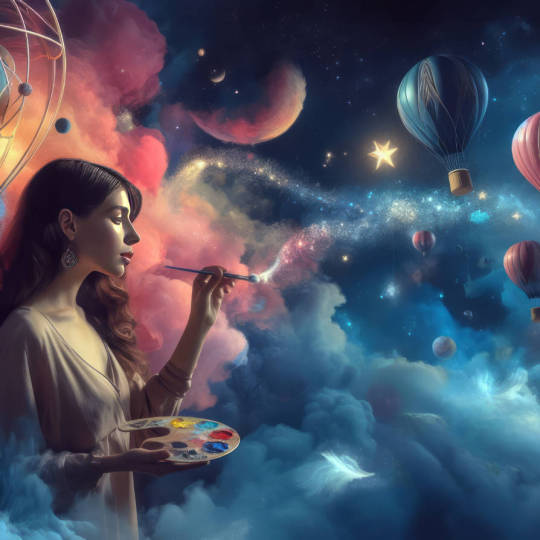
Abbandona la tua armatura, donna! Rinnova il tuo potere, Riscopri la tua bellezza, Abbraccia la tua fragilità. Sei la forza creatrice, sei l’amore che genera vita. Sei luce che illumina il mondo. Risplendi! Matrika art by_robopicasso_ ********************* Drop your armor, woman! Renew your power, Rediscover your beauty, Embrace your fragility. You are the creative force, you are the love that generates life. You are light that illuminates the world. Shine! Matrika art by_robopicasso_
9 notes
·
View notes